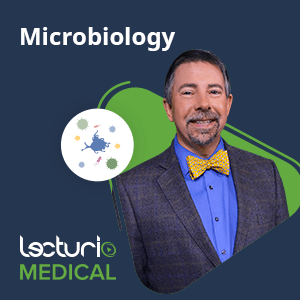Microbiology comes from the Greek words mīkros and bíos which mean “small life” when put together. These tiny creatures can be either the most fun or the hardest subjects in medical school. Honestly, it all boils down to your approach. Of course, everyone has a different way of studying, but we’ll be discussing a few tips that can help any medical student. So, what makes microbiology so difficult?
There are a lot of medically significant microbes. What’s more, they vary depending on geography. The most common diseases will change from place to place. Even communities can have different resistances to various antibiotics. Microbiology sounds crazy complex, right? Well, it’s complex, but not impossible to simplify and learn!
Why Should We Learn Microbiology?
Do we need microbiology? If your answer isn’t “yes” after going through the COVID-19 pandemic yourself, I don’t know what else will convince you. Although we can’t see them, no one can deny the significance of microbes. The bubonic plague wiped out a third of Europe. The Spanish flu, caused by H1N1, spread worldwide with a death toll of 100 million. Of course, we can’t forget the still-ongoing HIV/AIDS pandemic that continues to kill millions worldwide.
On the other hand, we have diseases that are close to being eradicated with the creation of vaccines. Smallpox is the only infectious disease eradicated from the face of the Earth. Diseases like poliomyelitis, malaria, and yaws are close to meeting the same fate. None of this would have been possible without the study of microbiology.
In short, knowing all these things saves lives.
The organisms might remain unseen, but the diseases they cause are very real. As a doctor, you’ll do more than treat these diseases. You’ll advocate for public health, help put an end to potentially fatal diseases, and practice antibiotic stewardship. But we’ll get to the latter in a bit. Let’s talk about how you can survive this barrage of bugs.
Take the Course: Microbiology
Cover all microbiology essentials with Sean Elliot, MD, from University of Arizona.
Study Tips for Microbiology
#1: Get the basics down first
The cell is the basic unit of life. I’m sure you’ve heard this many times before, but this is important in microbiology. If you haven’t gotten your cellular biology concepts down, this subject will be hard to follow. This includes genetics and the history of how microorganisms were discovered. Luckily, Lecturio has introductory lectures for you to follow if you don’t know where to start.
These things can seem basic at first, but you’ll find that microorganisms are far more complicated. Each bacteria has their unique pathogenesis. Viruses have different shapes and genetic material. Parasites have their own life cycles. Apart from that, you need to learn how to diagnose, treat, and prevent them. Did these concepts give me a hard time? Absolutely. Did I manage? Yes, because I always correlated the diseases with what I already knew. These concepts boil down to the basics you learn at the start. So make sure you at least get familiar with the fundamentals.
#2: Study everything in chunks
I said it once, and I’ll say it again: there are a lot of medically important organisms. This subject is almost purely memorization. It’s not like physiology, where form follows function. Some pathogeneses aren’t even fully understood yet. So you need to break these already-small microbes down into even smaller parts. I don’t mean literally, of course. I mean you should study them in small groups.
This is called chunking. For example, you can split bacteria into Gram positive or Gram negative. You can split parasites into protozoans, cestodes, trematodes, and nematodes. You can even go further and split the protozoans into ciliates and flagellates.


There are characteristics that make microbes alike and those that set them apart. At least if you group them together, you already know their similarities. Then, you’ll just have to study what makes each one special.
#3: Find or make your own visual aids
Although chunking is great in helping you memorize concepts and in making microbiology less overwhelming, visual aids are also a huge help. Of course, you can’t pick just any visual aids. You need to pick diagrams and flowcharts that really stick with you. Eye-catching and colorful diagrams can be helpful, especially when you’re the type who color codes their notes. This is even better if you draw the diagrams yourself instead of staring at the diagrams and hoping they stick.
For example, for identifying bacteria, you will need a flowchart to tell them apart. It can be hard to memorize, but as you draw it again and again, you can reproduce it on your own when the exam comes along. You might even find it more helpful to make your own visual stories or a mind palace. The possibilities in memory techniques are endless, but I highly encourage you to use your visual memory rather than just reading words from books.
#4: Use cases to study
In the medical field, people tend to joke about how infectious disease doctors take such in-depth medical histories. That’s not a joke. Infections react to the body differently and vice versa. So each microbe has a natural course as time goes on. Symptoms can change and – depending on the host – get better or worse. You’ll even have to figure out where these diseases came from. This can get confusing, but once you have a name or face to the disease, it might be easier to remember.
I’ve learned that the best way I recalled different infections was through reading case studies or seeing patients.
I’m not telling you to go out and find someone with Chagas disease or something. It’s not very common. But when you get the chance to see a relative who came down with chicken pox, or a patient who contracted salmonella, try to ask for their story, and try to do this in the safest and most respectful way possible. As for the rarer diseases, you might be better off watching Monsters Inside Me rather than risk exposing yourself.
#5: List down buzzwords
Like all of my readers, each microbe has something that makes them special. But it can be hard to remember because some diseases don’t sound like they have anything to do with the etiology. It’s not like anatomy, where you can derive function from their names. For example, “Mycobacterium” is called such because of its likeness to a fungus, but that tells you quite little about the diseases it can cause.
Instead, you’ll have to memorize by linking or associating words with a particular microbe. Why is it difficult? Because scientists enjoy naming diseases after themselves!
I can’t think of a single way to derive “Burkitt lymphoma” from “Epstein Barr Virus” the same way you can derive the muscle action and insertion from “flexor pollicis longus.”
What I would do is work with flashcards or make mnemonics. For example, I would say “Epstein BARR causes BARR-kitt.” It sounds silly, but the sillier, the better! Alternatively, you can draw a mindmap and connect all the concepts under one microbe together. In connecting as many related concepts as possible, you reinforce it into your memory.
#6: Do the diagnostics and treatment last
Once you have the microbes and their characteristics mastered, you can move to the diagnostics and treatment. Each bacteria has different agars that work for them, and different antibiotics effective against them.
It sounds complicated, but that’s why you should save this part for when you’ve already picked up the earlier concepts.
I cannot emphasize that enough. Why? Because the antimicrobials will target different parts of the microbes. You can’t just give antivirals for parasitic infections.
Moreover, there’s the whole topic of antimicrobial stewardship. This is one of your responsibilities as a doctor. As technology and medicine evolve, so do microorganisms. Unfortunately for us, due to irresponsible antibiotic prescription and use, we live in an age where we have pandrug-resistant bacteria. What’s that? It’s bacteria resistant to all current antibacterial agents. These infections are associated with high mortality for the obvious reason that they are so difficult to treat. Luckily, they’re very rare and we want to keep it that way. So as doctors, make sure you know the right antibiotics and when to use them.
How to Pass Microbiology Lab
Microbiology lab is where you get to use your microscope and slides and study microbes on your own. These sessions will be guided by your professors and workbooks, but most of the time you’ll study on your own. Here are a few tips for making the most out of your microbiology lab experience:
#1: Attend your lab sessions
It might seem like a waste of time to look at your slides when you could just as easily get photos from the internet, but lab sessions are more than that. It’s during these sessions that professors are free to answer any questions you have. They can give you tips on identifying organisms that you might not have known if you had studied at home.
It’s also in these sessions that you learn by doing, which is one of the more effective ways of learning. Sure, you can always read the steps involved in culturing bacteria or staining them. However, this is totally different from doing it yourself. You need to learn to perform lab techniques like it’s second nature, especially when you have practical exams. For that to happen, you need to practice doing lab procedures yourself. Your professors should be around to correct any mistakes you make so you don’t repeat them during a practical exam.
#2: Take photos, draw, and label
Take photos of your specimens and label them. This is even better if you can draw them yourself. How does this help? Drawing makes use of your visual, kinesthetic, and semantic memory. This combination increases your chances of recalling what microbes and their parts look like. Basically, it uses a variety of senses, and the more senses you use to memorize, the better.
You don’t have to be an artist. I know I’m not, and I did it anyway.
What’s important is that you draw it as best you can. You can even color code your drawings, if color helps you learn better. If you’re not feeling confident, here’s a photo of parasites that I made in my second year. Is it perfect? Nope. Do I have artistic skills? Definitely not. But I would be lying if I said this didn’t help me once the exam came along.
#3: Rehearse the steps of microbe identification
If you have practical exams, you might be asked to identify an unknown liquid with bacteria in it. To do this, you need to run multiple tests in a short period of time. This can be scary if it’s your first time doing it. Instead, do the tests yourself and run through the process as if it were the day of your exam. That way, you’ll only have to worry about memorizing which tests show positive results for which bacteria.
#4: Be careful
This isn’t really a study tip. I just think it’s important to observe proper safety practices to make the most of your experience. After all, no one should actually get sick from microbiology class. While the specimens you’re working with aren’t sufficient enough to cause disease, I still suggest to be safer than sorry. There are people around you who are more susceptible to contracting a disease. So remember to wear protective clothing, wash your hands, properly label everything, and dispose of waste in the correct bins. Of course, you’ll learn these basics on your first day, but always keep them in mind whenever you work in the lab.





